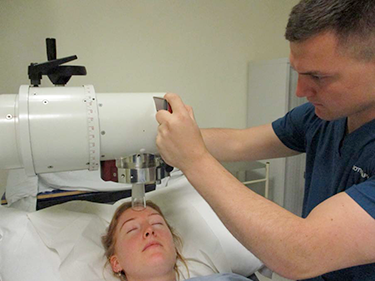Superficial radiotherapy to the skin
Superficial radiotherapy is a type of external radiotherapy. It treats cancer on or close to the skin surface. Superficial radiotherapy means that the radiation doesn't travel far into your body.
You can have superficial radiotherapy with low energy x-rays (photons) or electrons. Your doctor will decide which one you need. This depends on the size and depth of the cancer and where it is in the body.
Planning superficial radiotherapy
You have a planning appointment before you start radiotherapy. This is so that your treatment team can work out the dose of radiotherapy you need and exactly where you need it.
The planning for superficial radiotherapy usually involves your doctor marking with pen the area that needs treatment. Your therapy radiographers then take measurements and photographs. Sometimes they might also take a tracing of the area. This is so they can set you up in the correct position each time you have treatment.
Sometimes you might need to have a CT scan to check how deep the radiation needs to go. This takes a few minutes.
Mould room
Depending on the treatment area, you might have lead shielding made for you. This is to protect nearby areas of the body from radiation. For example, if you have skin cancer on your nose, your radiographer or mould room technician might make a narrow strip of lead to fit your nostril.
In some cases, they make a mould instead to fit the shape of the cancer and protect nearby healthy cells. This is individual to you and so you might need to go in for an extra appointment. Your radiographers will let you know if you do.
Having treatment
To have the treatment you lie on a radiotherapy couch. Your therapeutic radiographers help you get into the right position and put on any moulds or shields that you might need. They use the photographs, measurements and tracings to get you in the correct position.
Your radiographers put part of the machine (applicators) on or close to your skin. This won't hurt. The machine stays in this position for the whole treatment. The treatment usually lasts a few minutes.
Your radiographers go out of the room for a few minutes while you have the treatment. They can see and hear you the whole time. You can't feel anything when you actually have the treatment.
After treatment, your radiographers go back into the room and help you off the couch. You can then go home. You are not radioactive so can be around other people, including children.
Your doctor will tell you how many days you have radiotherapy for. This can vary from a single day to every week day for up to about 6 weeks.
Types of machines for superficial radiotherapy
LINAC machine – using electrons
You have electron treatments on a LINAC. A LINAC is the most common radiotherapy machine. Radiographers attach extra parts (applicators) to the LINAC to treat skin cancer with electrons.

Superficial x-ray machine – using low energy x-rays
Low energy photon treatments use a much smaller machine than a LINAC. It has many movable parts and is usually on wheels.

Possible side effects
Your skin in the treatment area is likely to get red or sore after having superficial radiotherapy. It might scab or more rarely bleed. The side effects may carry on for a few weeks after treatment before they start to get better.
Your hair will also fall out in the area being treated. Sometimes this hair loss can be permanent.
Skin care advice
During treatment you should:
• keep the treatment area out of the sun or use a high SPF sun block
• use unfragranced simple soap and moisturiser
• pat your skin dry with a towel
• avoid swimming (and for a few weeks afterwards)
Months or years later, your skin might look paler or you might see small veins in the treatment area. Your skin will be much more sensitive to the sun and you should continue to try to keep the area out of the sun or use a high SPF sun block.
Your radiographers will give you more information about skin care during and after treatment.



